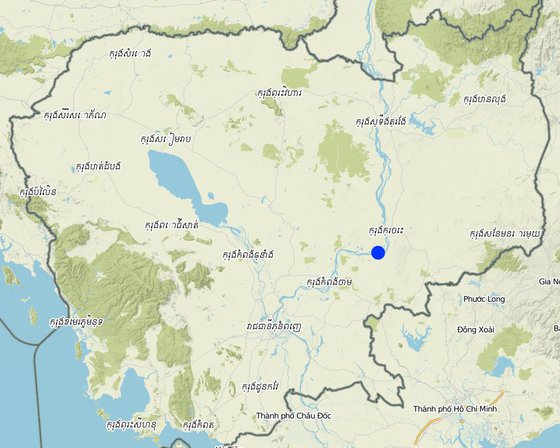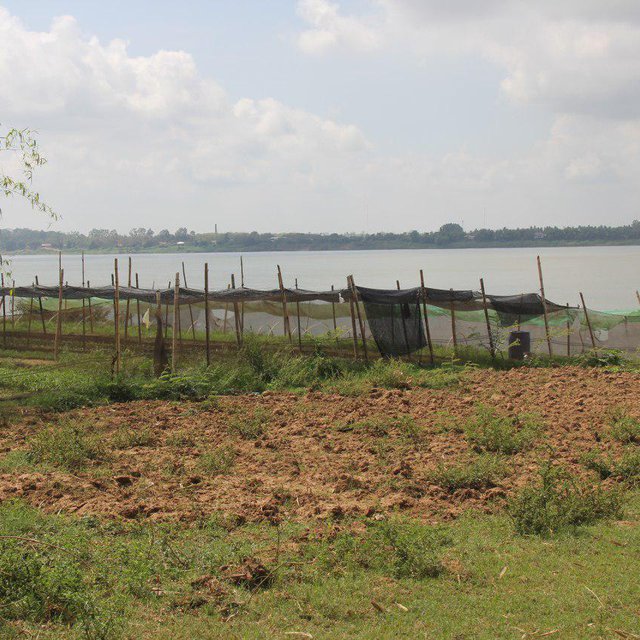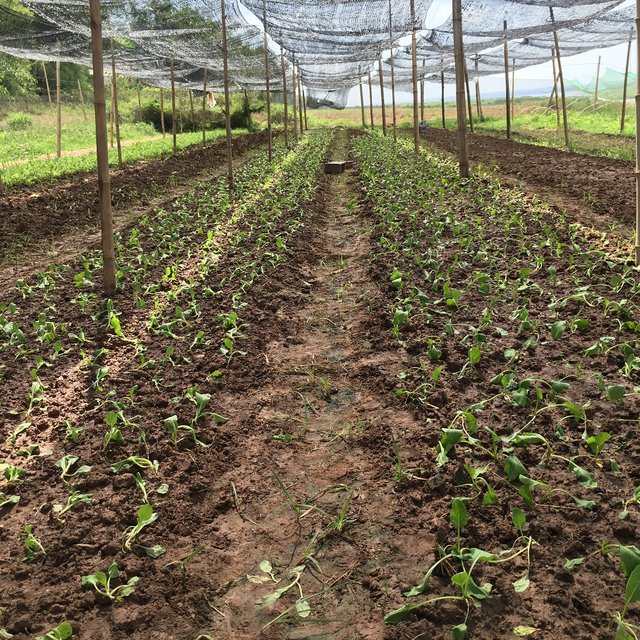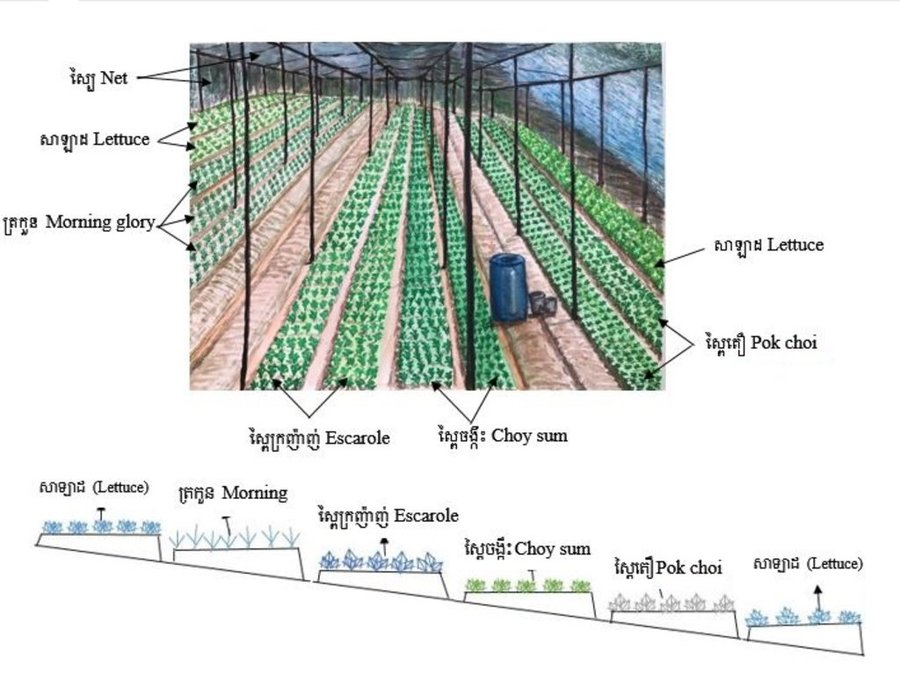



Intercropping is a technique of cropping in which two or more crops are grown in different alternate rows at the same time (Pawan et al., 2012). The crops grown by the farmers are lettuce, pak choi, choy sum, escarole and morning glory. This technique was applied using 1080 square meters of land along the Mekong's river bank in Kratie province. In applying this technique, the farmer prepared the land, after which he prepared the rows across the slope of the river bank. Lettuce was planted in the first row, then pak choi, choy sum, escarole, and then morning glory, with the crop sequence being repeated in the following rows. Intercropping helps to reduce the damage from insects. Lettuce is a crop that insects dislike because of its bitter taste. Under the intercropping practice with the vegetables that insects dislike, the level of insect damage is reduced because, when facing such repellent crops, the insects normally disappear rather than go to the next row, even though it might be a crop they like.
Crops are easily damaged by insects when grown as a single species that insects like. In intercropping, even if the insects damage one crop, the other crops often survive without insect damage. To apply this technology more effectively, farmer used botanical pesticide that was produced by the farmer himself based on plant ingredients such as neem bark, boraphed, strychnine plant, derris, etc. Such natural pesticide ingredients are crushed and soaked in water for 15 days, after which l liter is mixed with 15 liters of water(Yang et al., 2006). The solution is sprayed on the crops on a daily basis when insects are present.
Soil preparation: The soil is ploughed and dried for 7 to 8 days, then aligned into rows with lime being applied for a period of 6 days to disperse the bad bacteria in the soil. Nursery preparation of escarole, pak choi and choy sum takes about 20 days before transplanting (morning glory was planted by direct seeding). Lettuce is only 10 days old when it is transplanted. Lettuce can be harvested within 30 days after transplanting, while morning glory is grown for about 38 days before being harvested. The farmer used organic fertilizer and cow manure to improve the soil fertility. The farmer makes the rows across the slope of the river to prevent soil erosion during heavy rainfall. To provide protection from the potential adverse effects of direct sunlight and rain, the farmer used a temporary 2 meters high net roof supported by bamboo poles, to provide cover. A net fence was also constructed around the crop area to provide protection from animals such as dogs and chickens. In relation to produce price, pak choi returned 3.500 to 4.000 riel per kilogram, morning glory 2.000 riels per kilogram, choy sum 2.000 to 3.000 riel per kilogram, escarole 3.000 to 3.500 riel per kilogram and lettuce 4.000 riel per kilogram.

Location: Land is along Mekong River, Ta Mau Leu village, Kampong Kor Commune, Preaek Prasab District, Kratie Province, Cambodia
No. of Technology sites analysed: single site
Spread of the Technology: applied at specific points/ concentrated on a small area
In a permanently protected area?:
Date of implementation: less than 10 years ago (recently)
Type of introduction









| Specify input | Unit | Quantity | Costs per Unit (KHR) | Total costs per input (KHR) | % of costs borne by land users |
| Labour | |||||
| Prepare soil | person-day | 3.0 | 17000.0 | 51000.0 | 100.0 |
| Equipment | |||||
| Pumping machine | set | 1.0 | 1000000.0 | 1000000.0 | 100.0 |
| Hoe | piece | 1.0 | 13000.0 | 13000.0 | 100.0 |
| Rake | piece | 1.0 | 15000.0 | 15000.0 | 100.0 |
| Hose | piece | 14.0 | 16000.0 | 224000.0 | 100.0 |
| Big basket | pair | 1.0 | 50000.0 | 50000.0 | 100.0 |
| Plant material | |||||
| Seed of lettuce | package | 15.0 | 10000.0 | 150000.0 | 100.0 |
| Choy sum | package | 15.0 | 6000.0 | 90000.0 | 100.0 |
| Escarole | package | 6.0 | 6000.0 | 36000.0 | 100.0 |
| Morning glory | kilogram | 14.0 | 10000.0 | 140000.0 | 100.0 |
| Pok Choi | Can | 2.0 | 7000.0 | 14000.0 | 100.0 |
| Fertilizers and biocides | |||||
| Lime | kilogram | 2.0 | 2500.0 | 5000.0 | 100.0 |
| Organic fertilizer | sack | 1.0 | 130000.0 | 130000.0 | 100.0 |
| Construction material | |||||
| Net | piece | 3.0 | 260000.0 | 780000.0 | 100.0 |
| water tank | pair | 1.0 | 50000.0 | 50000.0 | 100.0 |
| Big plastic bowl | piece | 3.0 | 10000.0 | 30000.0 | 100.0 |
| storage tank | piece | 1.0 | 80000.0 | 80000.0 | 100.0 |
| Nylon net for the construction for a protective border fence. | piece | 3.0 | 58000.0 | 174000.0 | 100.0 |
| Other | |||||
| Rent land | year | 1.0 | 300000.0 | 300000.0 | 100.0 |
| Bamboo | pole | 20.0 | 4000.0 | 80000.0 | 100.0 |
| Total costs for establishment of the Technology | 3'412'000.0 | ||||
| Specify input | Unit | Quantity | Costs per Unit (KHR) | Total costs per input (KHR) | % of costs borne by land users |
| Labour | |||||
| weeding (by farmer) | person-day | 4.0 | 17000.0 | 68000.0 | 100.0 |
| prepare soil and put fertilizer ( by farmer) | person-day | 4.0 | 17000.0 | 68000.0 | 100.0 |
| Spray pesticide | person-day | 12.0 | 17000.0 | 204000.0 | 100.0 |
| Equipment | |||||
| Pesticide sprayer equipment use by hand | set | 1.0 | 80000.0 | 80000.0 | 100.0 |
| Diesel | liter | 90.0 | 2350.0 | 211500.0 | 100.0 |
| Total costs for maintenance of the Technology | 631'500.0 | ||||
Before farmer grew only onion but now grows several crops.
Before farmer used chemical pesticide and chemical fertilizer but now farmer uses botanical pesticide and natural fertilizer.
The farmer does the intercropping that helps to reduce damage from insects and he also uses only botanical pesticide.
Before farmer grew only onion but now farmer grows multiple crops such as Escarole, Choy sum, Pok choi, Lettuce and Morning glory.
Because of the intercropping and crop rotation the crops absorb different nutrients from soil. Natural fertilizer makes soil rich in nutrition.
There is no water pollution because no more chemical pesticide is used, he uses only botanical pesticide.
Before he bought chemical pesticides against insects, now he uses botanical pesticide because he can do it by himself.
Reducing chemical fertilizer and pesticide use and instead using natural fertilizer and botanical pesticide.
The farmer livelihood is better after practicing this technology because farmer gets more money by having more crops, there is no need to buy chemical pesticides and he has a healthy life.
Workload is a bit increased because of different crops.
For food security is better than before because farmer can get better income, before grew only one crop but now he changed to grow multiple crops.
No use of chemical pesticide which harms the health.
Farmer can made botanical pesticide by himself and uses natural fertilizer.
Flooding make loss loamy soil and increase level sedimentation at down stream by plough or ridge soil at river bank
Use net roof and create ridge of the row across the slope of the river bank to reduce water flow.
Cover crops can protect soil moisture and net roof is reducing 60% of evaporation.
The cover crops can keep good soil moisture.
Farmer uses cow manure bough from other farmers or collect at the rice field and organic fertilizer bought from the fertilizer company.
In intercropping each crop and rotation techniques absorbs different nutrients and this creates a balance.
Reduce diamond-back moth, striped flea beetle and black cutworm.
When the land user ploughs the soil and rakes it, some topsoil will be removed when there is rainfall. To minimize the soil surface runoff, farmer constructed the bamboo pole with the net roof and created a ridge of the row across the slope of the river bank, so the soil sediment flow is increased only very little.